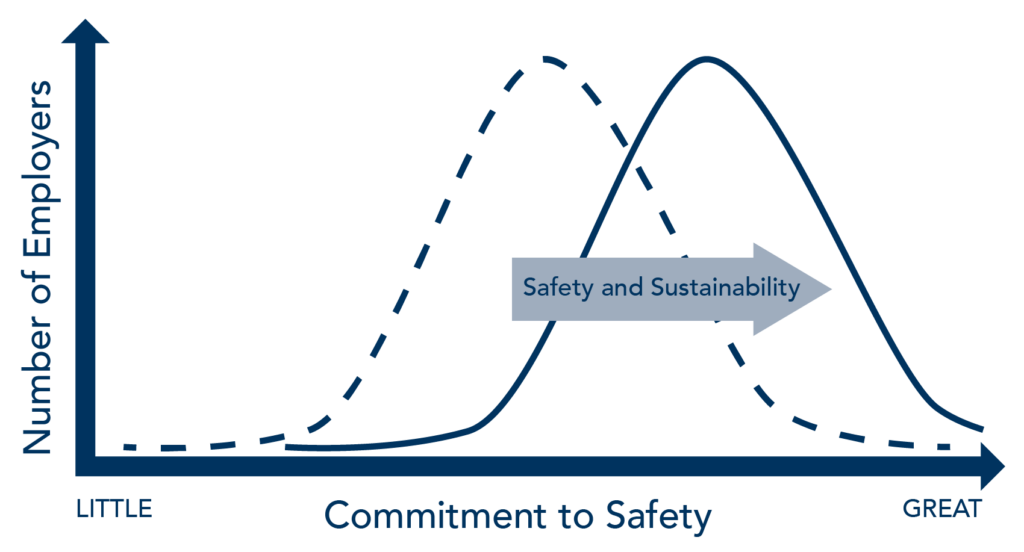16.3: HR and Health and Safety
- Page ID
- 47165
- Discuss human resource management’s role in supporting workplace health and safety
 Given their responsibility for people, culture, and associated policies and procedures, human resource management plays a critical role in supporting workplace health and safety. The points made in OSHA’s Be Safe + Sound Management Leadership Guide are particularly relevant to HR management, and include:
Given their responsibility for people, culture, and associated policies and procedures, human resource management plays a critical role in supporting workplace health and safety. The points made in OSHA’s Be Safe + Sound Management Leadership Guide are particularly relevant to HR management, and include:
- Making worker safety and health a core organizational value
- Eliminating hazards, protecting workers, and continuously improving workplace safety and health
- Providing sufficient resources to implement and maintain the safety and health program
- Visibly demonstrate and communicate their safety and health commitment to workers and others.
For example, HR management has a responsibility to ensure that the organization is in compliance with OSH Act requirements and that supervisors and managers understand that it is their duty to ensure that the workplace is free from recognized hazards that are causing or likely to cause death or serious physical harm. Management training and evaluation should ensure that managers understand employee rights, including, for example, the right to safety training in a language that the employee understands.
This duty of care also extends to workplace violence, which includes “any act or threat of physical violence, harassment, intimidation, or other threatening disruptive behavior that occurs at the work site”[1] As discussed previously, workplace violence ranges from threats and verbal abuse to homicide. SHRM research indicates that approximately 33% of American employees and almost 20% of HR professionals either don’t know are unsure of what to do if they witness or are involved in a workplace violence incident.[2] Research also found that while the majority of HR professionals reported having developed workplace violence training, one third didn’t provide training to employees. Additionally, while almost all HR professionals reported having a process for identifying employees with a history of violence, over 50% were unsure of whether they have a workplace violence prevention program. As SHRM-SCP, SHRM president and CEO Johnny C. Taylor, Jr. stated: “Companies and HR should and must do more to make employees feel safe at work,” adding that “If you make the investment in security and preparation, your employees will feel safer and respect you for valuing their safety.”
OSHA Resources
OSHA recognizes that its regulatory and enforcement efforts alone are inadequate to achieve the compliance of over 10 million employers. That’s where outreach activities come in. Specifically, OSHA’s consulting, training and outreach efforts are designed to shift the safety curve, prompting organizations to adopt Safety and Health Programs that build a culture of and commitment to safety, as illustrated in Figure 1.

To that end, OSHA offers are range of consulting services, training and supporting resources, including the following:
- An OSHA Compliance Quick Start Tool
- On-Site Consultation—Free and confidential occupational safety and health services for small- and medium-sized businesses.
- A broad range of safety and health tools, publications and guides for specific OSHA standards, programs (e.g., SHP) and safety and health topics (e.g., Workplace Violence)
- OSHA’s Safe and Sound page—everything you need to develop and implement a safety and health program
- Recognition (“Cooperative”) programs
- A range of data and statistics and informational resources, including its QuickTakes bi-weekly e-newsletter
Note that the OSHA website is available in both English and Spanish.
- "Workplace Violence." Occupation Safety and Health Administration, United States Department of Labor. Accessed August 20, 2019. ↵
- "With Workplace Violence on the Rise, 1 out of 7 People Don't Feel Safe at Work." Society for Human Resource Management. March 19, 2019. Accessed August 20, 2019. ↵
Contributors and Attributions
- US-OSHA-Logo. Provided by: Wikimedia Commons. Located at: https://commons.wikimedia.org/wiki/File:US-OSHA-Logo.svg. License: Public Domain: No Known Copyright
- Modification of Shifting the Safety Curve. Provided by: OSHA. Located at: www.osha.gov/sustainability/docs/OSHA_sustainability_paper.pdf. License: Public Domain: No Known Copyright


